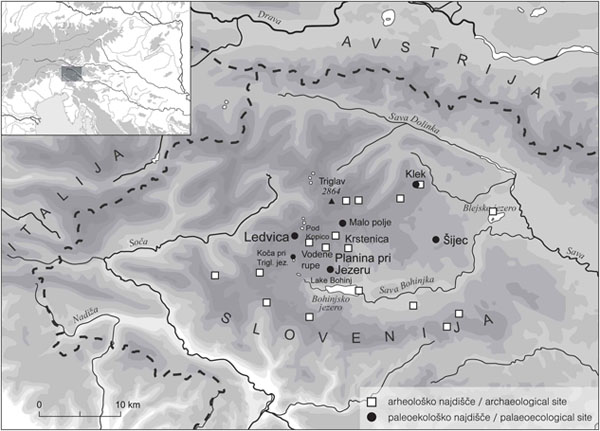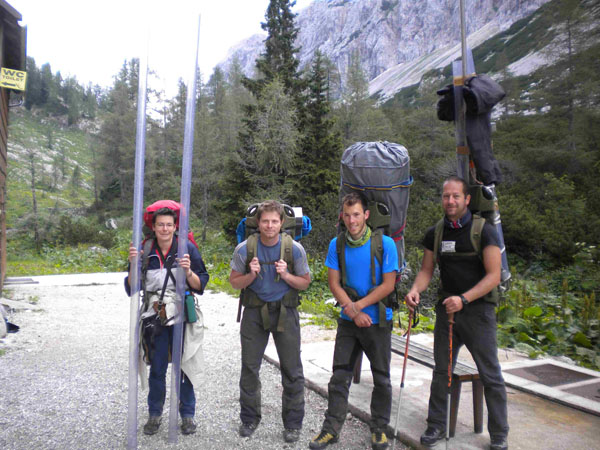5000 years of grazing and mining activities in the Julian Alps (Slovenia): climate-human interactions as reflected in lake sediments, man-modified landscape and archaeological findings
-
Original Title
5000 LET PAŠE IN RUDARJENJA V JULIJSKIH ALPAH: proučevanje jezerskih sedimentov, antropogeno preoblikovane krajine in arheoloških najdb ter rekonstrukcija vpliva klime in človeka na okolje
Project Team
Nina Caf, PhD, Jana Horvat, PhD, Borut Toškan, PhD, Tjaša Tolar, PhD, Špela Goričan, PhD, Prof. Aleksander Horvat, PhD-
Project ID
J7-1817
-
Duration
1 July 2019–30 June 2022 -
SICRIS
https://cris.cobiss.net/ecris/si/en/project/17889 -
Project Leader
-
Financial Source

Partners
EDYTEM, Universite Savoie Mont Blanc, Chambery, France, Department of Geology, Faculty of Natural Sciences and Engineering, University …, Ivan Rakovec Institute of Palaeontology
This multidisciplinary research project integrated palaeoecological, archaeological, and geological research in order to better understand changes in the natural environment, and human impact and adaptation to these changes. Our research focused on studies of the Holocene environment, archaeological settlement pattern and the economy at different altitudes of Julian Alps, especially in high-altitude vegetation belts. For the first time in Slovenia, a detailed palaeoecological research for the entire Holocene (radiocarbon dating, pollen, microcharcoal, geochemical and sedimentological analyses) of cores collected in mountain lakes of ‘Jezero na Planini pri Jezeru’ and ‘Ledvica’ were completed. Palaeoenvironmental changes of wetland near Srednja vas in Bohinj, Lake Bled, and Šijec peat bog were also studied. Detailed archaeological and geological research (field surveys, test-pits, studies of architecture and artefacts, dating, archaeobotanical and archaeozoological research) in the alpine grazing areas revealed changes of archaeological settlement patterns through time, with a special emphasis on the beginning of grazing and mining.

Study area
The following research questions were addressed: What environmental changes were triggered by climate fluctuations and which due to human influence (e.g., cutting/burning forest, pasture, metallurgy)? What was the impact of climate change on human presence and activities? When did the first mountain pastures appear and how did this change the environment? How did mining and metallurgical activities affect the vegetation, soil erosion processes, and the ecology of lakes? How did centuries of intensive mining transform the landscape? How is the balance between sustainable management and excessive exploitation reflected over time?
In the final phase of the project, the palaeoecological and archaeological results were analysed. The archaeological settlement pattern and the vegetation in mountain areas of Julian Alps were compared with wider region (Slovenia, Europe). The comparison of well-dated multi-proxy data helps us to better understand the reasons for changes of archaeological settlement patterns, the economy and society. This knowledge will help us to protect and preserve the abundant natural and cultural heritage of Triglav Natural Park.

Some members of the research group
Project group
1. Institute of Archaeology, ZRC SAZU
- Maja Andrič (palynological research)
- Nina Caf (palynological research)
- Jana Horvat (archaeological research)
- Borut Toškan (archaeozoological research)
- Tjaša Tolar (archaeobotanical research)
2. Ivan Rakovec Institute of Palaeontology ZRC SAZU
- Špela Goričan (geological research)
- Aleksander Horvat (geological research)
3. Department of Geology, Faculty of Natural Sciences and Engineering, University of Ljubljana
- Andrej Šmuc (geological and mineralogical research)
4. EDYTEM, Universite Savoie Mont Blanc, Chambery, France
- Pierre Sabatier (sedimentological and geochemical research)
Research project focused on:
1. Sedimentary processes in lakes, changes of the Holocene vegetation, and human impact on the environment of the Julian Alps
High-resolution multidisciplinary palaeoecological research was carried out on sedimentary cores from: lakes 'Jezero na Planini pri Jezeru', 'Jezero v Ledvici', Lake Bled, Srednja vas wetland, and Šijec peat bog. All study sites were cored by Livingstone piston corer; in Srednja vas the top meter of the sediment was collected from a trench, as a stratigraphic column using metal boxes. Samples were 14C (plant macrofossils and bulk sediment) and 210Pb dated. Palynological, mineralogical, sedimentological and geochemical analyses were performed using standard laboratory protocols (see References below).
Results
In the Lateglacial a vegetation, characteristic for cold climate (e.g. pine, birch, grasses) was growing in the Julian Alps. At the Lateglacial-Holocene transition 11.700 years ago, the climate became warmer and wetter. Small lakes were established at Planina pri jezeru and Šijec peat bog and tree taxa (spruce, larch, oak, elm), and hazel, began to spread. Beech and fir that need wetter climate, spread later, ca. 9900 and 8000 years ago. Human impact on the environment shows as changes in landscape openness (a decrease of tree and an increase of herb pollen) and the composition of forests. Pollen of cultivated and ruderal plants, and plants characteristic for pastures, appear. In the Neolithic human impact on the environment of the Julian Alps was week (small-scale opening of the landscape, individual pollen grains of cereals and ribwort plantain). No archaeological sites dated to this period were discovered yet, but palynological data suggest that people were presumably present in the landscape in that their sites might be discovered in the future. In the Bronze Age, when numerous archaeological sites were discovered in the mountains, we noticed an increase of anthropogenic indicator taxa (cereals, ribworth plantain, coprophilous fungi Sporormiella) and a decline of fir pollen, which was presumably caused by grazing. People also triggered soil erosion (e.g. Iron Age, Lake Bohinj, cutting beech forests, 10-times increase of sedimentation rates), and affected trophic conditions in alpine lakes (e.g. eutrophication of ‘Jezero na Planini pri jezeru’ in the 16th century AD, which shows as an increase of calcite, high δ13C and low C/N values) and the composition of forests (e.g. decline of fir since the Bronze Age due to forest grazing, decline of beech due to metallurgic activities, especially in the period of most intensive ironwork, 1580-1880 AD, all sites). Intense use of the middle, montane vegetation belt started only in the Middle Ages when grazing area at Planina pri jezeru formed. Climate fluctuations affected chemical composition of lake sediments (e.g. in increase of quartz, illite, K/Ti, δ13C, and beech pollen at Lake Bohinj), which was detected in a wider Alpine region (see references cited below).
2. Human activities in high-altitude areas, especially the beginnings of mountain grazing and metallurgy
In the years 2019 and 2021-2022 systematic archaeological surveys were carried out at ‘Fužinarske planine’, ‘Spodnje bohinjske planine’, and above ‘Zgornja Krma’. Surface remains were documented and test trenches excavated at following study sites: Pod Rodico, Srenjski preval pod Viševnikom, Dedno polje, Ovčarija, Pri utah v dolini Triglavskih jezer, Lopučnica, Štapce, Osredki, Konjsko sedlo, Vodene rupe, Klek, Planina pod Mišelj vrhom, Pod Kopico in Veliki Pršivec. A catalogue of high-altitude archaeological sites in the Alps was updated, focusing on the location of study sites, characteristics of dwellings and their age. Study sites were dated by typology of small finds, and radiocarbon dating (ten C14 dates). In 2019 archaeological site Vodene rupe was excavated in cooperation with researchers of ArheoAlpe. In 2021 the site Pod Kopico was also excavated. We studied iron ore from archaeological sites Dolga Planja, Klek and Pečana.
Results
Archaeological sites are dated between the Early Bronze Age (end of 4th millennium BC) and the Early Middle Ages (7th-10th century AD). The earliest archaeological sites are dated to the end of 4th and the beginning of 3rd millennium BC. The area was settled again in the Younger and Late Bronze Age, with numerous archaeological sites dated to 13th-9th centuries BC. A large number of archaeological sites, dated to the Roman Age, Late Antiquity and Early Middle Ages were also discovered. Increases and declines of the number of archaeological sites until the 5th century AD matches with the situation in other areas of the Eastern Alps. However, a relatively large number of Late Antiquity and especially Early Medieval sites was discovered in the Julian Alps, which is in contrast with other regions. People settled lower areas of large grassy areas, located between 1450-1800 m a.s.l. The same location was often used in different archaeological periods. For example, at Vodene rupe, cultural layers dated to the Iron Age and a building dated to Late Antiquity were discovered. The first buildings with stone foundations presumably appear already in the Bronze Age (Pod Kopico). Surface ore (bobovec) was collected at least from the Early Middle Ages. The results of research at Dolga Planja suggests that bobovec was crushed before it was transported to the lowlands. At Pečana strudy site iron ore was excavated in the Early Middle Ages (see references below).
1. Sedimentary processes in lakes, changes of the Holocene vegetation, and human impact on the environment of the Julian Alps
- CAF, Nina, SABATIER, Pierre, ŠMUC, Andrej, OGRINC, Nives, DOLENEC, Matej, RAPUC, William, POTOČNIK, Doris, GRAFENSTEIN, Ulrich von, ANDRIČ, Maja. Multi-proxy reconstruction of the Holocene vegetation and land use dynamics in the Julian Alps, north-west Slovenia. Journal of quaternary science 38 (1), 2023, 107−122, https://onlinelibrary.wiley.com/doi/pdf/10.1002/jqs.3461.
- ANDRIČ, Maja, SABATIER, Pierre, RAPUC, William, OGRINC, Nives, DOLENEC, Matej, ARNAUD, Fabien, GRAFENSTEIN, Ulrich von, ŠMUC, Andrej. Vpliv človekovih aktivnosti (paša, poljedelstvo, rudarjenje) in klimatskih nihanj na rastlinstvo v povodju Bohinjskega jezera v zadnjih 6600 letih. − In: Ogrin M., Horvat J., Bizjak J., Langus K. (ur.), Življenje v Alpah, 2020, Bohinjska Bistrica, ArheoAlpe in Turizem Bohinj, 73−84.
- CAF N., SABATIER P., ŠMUC A., OGRINC N., DOLENEC M., RAPUC W., POTOČNIK D., von GRAFENSTEIN U., ANDRIČ M. 2022. Holocene changes in vegetation cover and lake dynamics due to natural and human impact in the Julian Alps, Slovenia. In: FAGANELI, Jadran (ur.), OGRINC, Nives (ur.). 15th International Symposium on the Interactions Between Sediments and Water : Piran, Slovenia, June 12-15, 2022 : book of abstracts. Piran: National Institute of Biology, Marine Biological Station,; Ljubljana: Jožef Stefan Institute, 23, [COBISS.SI-ID 114132995]
- CAF N., SABATIER P., ŠMUC A., RAPUC W., von GRAFENSTEIN U., ARNAUD F., ANDRIČ M. 2019. The Holocene vegetation dynamics and human influence on the Alpine environment in the Julian Alps, Slovenia: P-2262. In: Programme code. 20th Congress of the International Union for Quaternary Research (INQUA), Dublin, Ireland, 25th - 31st July 2019, [COBISS.SI-ID 44992301]
- CAF N., SABATIER P., ŠMUC A., OGRINC N., DOLENEC M., RAPUC W., POTOČNIK D., von GRAFENSTEIN U., ANDRIČ M. 2021. First continuous reconstruction of climatic and human impact on the highlands of the Julian Alps. In: JAMŠEK RUPNIK, Petra (ur.), NOVAK, Ana (ur.). 6th Regional Scientific Meeting on Quaternary Geology : Seas, Lakes and Rivers : 27-29 September 2021, Ljubljana, Slovenia : book of abstracts. Online ed. Ljubljana: Geološki zavod Slovenije, 11, [COBISS.SI-ID 80154115]
- ANDRIČ M., SABATIER P., RAPUC W., OGRINC N., ARNAUD F., von GRAFENSTEIN U., ŠMUC A. 2019. 6600 years of human impact on lake-catchment and vegetation at Lake Bohinj (Julian Alps, Slovenia): P-4240. In: Programme code. 20th Congress of the International Union for Quaternary Research (INQUA), Dublin, Ireland, 25th - 31st July 2019, [COBISS.SI-ID 44992557]
- ANDRIČ, Maja, CAF, Nina. Palinološke raziskave : spremembe nekdanje vegetacije v Julijskih Alpah : predavanje, "Majski botanični večer", kombinirana izvedba dogodka v prostorih Gimnazije Bežigrad, Ljubljana (SLO) in po videopovezavi Zoom, 8. maja 2023. [COBISS.SI-ID 151634179]
2. Human activities in high-altitude areas, especially the beginnings of mountain grazing and metallurgy
- HORVAT, Jana. Inhabiting the high mountains of the South-Eastern Alps : Slovenia. In: Internationales Symposium Archäologie und Geschichte Siedlung und Wirtschaft im alpinen Raum, 24. und 25. November 2018 in Haus im Ennstal. Haus i. E.: ANISA, Verein für alpine Forschung, cop. 2019. Str. 1-29, ilustr., zvd. Forschungsberichte der ANISA für das Internet, 1. http://www.anisa.at/Tagung_%20ANISA_2018_Archaeologie.html. [COBISS.SI-ID 45761581]
- HORVAT J. 2020. Arheološke sledi v slovenskem visokogorju = Archaeological traces in Slovene mountain areas. In: Življenje v Alpah: življenje v Alpah nekoč in danes - od prve obljudenosti visokogorskega sveta pred več tisoč leti do trajnostnega razvoja turizma danes : zbornik posveta 6. oktobra 2017 v Stari Fužini v Bohinju. Bohinjska Bistrica: ArheoAlpe, zavod za kulturo, izobraževanje in turizem Bohinj; Stara Fužina: Turizem Bohinj, 11-25, [COBISS.SI-ID 42396419]